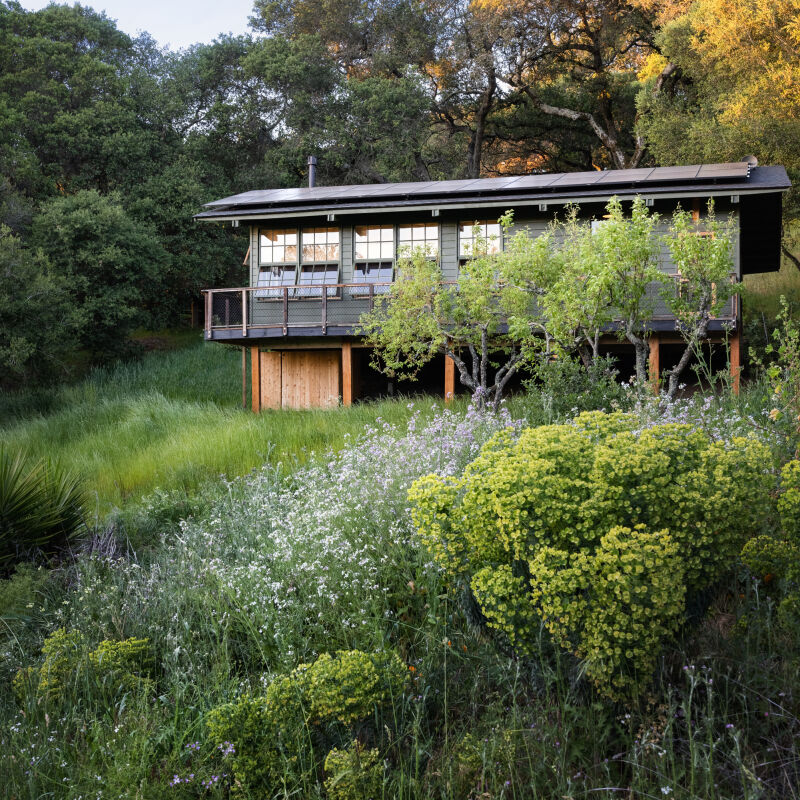In the warmer, brighter months, we love to dine outside and host parties on the balcony, porch, or in our garden. So why not make it easier and cook outside, too? We’re ever admirers of outdoor kitchens, which bring all of the function of an indoor cook space to the patio or poolside, so you can prepare sumptuous meals without having to miss a minute of a get-together (or haul platters from the kitchen to the backyard).
Whether you have a tiny space and budget—enough for basic appliances like a grill, outdoor sink, small counter, and perhaps a mini fridge—or are ready to splash out on something more full-scale, Appliances Connection can help you realize your ideal outdoor kitchen. A one-stop online purveyor of appliances, fixtures, and plumbing essentials, from budget to luxury, they carry more than 300 appliance brands and have over 50,000 items in stock and ready to ship, so you can get your outdoor kitchen up and running asap.
Not sure where to start? Here are a few expert tips for creating an enviable outdoor kitchen—no matter your space or budget.

1. Evaluate your space.
Planning an outdoor kitchen starts as any remodel does: by considering your existing space. How much room do you have? Is there a level, clear area where your kitchen can go? What layout—single-counter, island, U-shape, L-shape—fits best?
Albert Fouerti, founder and CEO of Appliances Connection, points out that for open-air kitchens in particular, it’s important to ensure a good flow that also is out of the way of other outdoor activities (like backyard games and running kids). You’ll also need to answer a key question: Will this be an extension of your indoor kitchen, working in conjunction with it, or will it serve as a standalone kitchen? The answer likely has to do with how much space you have and how far away your kitchen is from your backyard or patio—it’ll help determine your design and appliances selection.

2. Come up with a budget.
From simple to luxurious, outdoor kitchens can vary greatly. Your budget, as well as space constraints, will determine which is best for you. Here, a breakdown of the possibilities based on budget parameters and average costs for grills, outdoor-safe refrigerators, sinks and faucets, kegerators and more:
$4,000 and under: Grill ($1,700; the Weber Genesis Series 62 Inch Freestanding Natural Gas Grill is $999) + under-counter refrigerator (about $500) + optional sink and faucet (about $800)
$4,000-$10,000: Grill ($1,700) + full-size refrigerator ($1,000) + upgraded sink and faucet ($1,200) + optional add-ons like a pizza oven ($1,800)
$10,000+: Premium grill ($5,000) + sink and faucet ($1,500) + refrigerator ($1,000) + ice maker ($1,800) + pizza oven ($1,800) + ventilation for grills with higher BTUs ($1,500), plus entertaining add-ons like a kegerator ($1,500) or ice maker (the Summit 15-Inch Built-In Ice Maker is $1,632).

3. Build your kitchen.
Just like an indoor cooking space, an outdoor kitchen needs a few key components, including fixtures for cooking, refrigeration, and plumbing—all specifically designed for safe use outdoors—and an area for both prep and storage. Retailers offer a wide range of options for each, from budget to luxe, so you can pick and choose the components that work for you (or go with a ready-to-go kitchen package).

4. Don’t forget the essentials.
In addition to appliances, don’t forget practicalities like built-in trash and recycling for easy disposal while cooking (and to keep pests at bay), an ice maker to avoid constantly filling ice trays, and, of course, a sink for prepping produce and cleaning up.
And ask yourself a few questions as you decide on appliances and layout: Will you need to set up plumbing, gas, or electric lines to your outdoor space? What about drainage for rainwater? Remember that construction of permanent structures usually requires permits, footings, and inspection by municipal engineers, advises Fouerti. Check with your local zoning board or city building department before embarking on the project.

5. Wiggle room in the budget? Splurge on an extra (or two).
Once you’ve gotten the essentials in place, if you still have money in your budget, consider adding an accessory that will make your outdoor space that much more usable and enjoyable. Love entertaining for a crowd? Add a pizza oven: Fouerti recommends the popular XO Outdoor 40-Inch Wood-Fired Pizza Oven, ($3,149); if your budget is limited, consider the Forte 14-Inch Portable Pellet Pizza Oven ($224.99). For summer cocktail hours, a wine fridge or kegerator keeps beverages cold and at the ready, separate from the fridge for meats and veggies by the grill.

6. Prepare for the weather.
Make sure to choose materials specifically designed for outdoor use: Appliances Connection surveyed a group of designers, who recommend stainless-steel, teak, or cypress cabinets; Dekton or concrete counters; and UV-resistant materials. Anything with a water line (i.e., a sink) will need to be winterized in the colder months. And an expert tip? Figure out where the sun will be in relation to your kitchen and seating, Allie Mann, senior designer for Case Design/Remodeling in Bethesda, MD, told Appliances Connection. You don’t want sun (or wind) in your face; orient a different way, or consider a screen or fabric shade.

7. Set the scene.
Last but not least, add accessories like outdoor lighting, dining furniture, and maybe even a fire pit (like the Safavieh Bangkok Fire Pit) to create an open-air space for cooking (and eating) in all summer long.
To outfit your outdoor kitchen and see more tips, head to Appliances Connection.
Frequently asked questions
What are the key considerations when remodeling an outdoor kitchen?
When remodeling an outdoor kitchen, some key considerations include:
Location and layout: Determine the best location for your outdoor kitchen and plan the layout to optimize functionality and flow.
Appliances and equipment: Choose outdoor-rated appliances and equipment that can withstand outdoor conditions, such as grills, refrigerators, sinks, and storage cabinets.
Materials: Select weather-resistant and durable materials for countertops, flooring, cabinets, and backsplashes, considering factors like heat, moisture, and UV exposure.
Utilities and infrastructure: Ensure proper access to utilities like gas, water, and electricity, and consider the need for additional plumbing or electrical work during the remodel.
Ventilation and safety: Incorporate proper ventilation systems to manage smoke and odors, and prioritize safety features like fire-resistant materials, proper gas line installation, and electrical safety measures.
Lighting and ambiance: Plan for appropriate lighting to enhance functionality and create a pleasant atmosphere in the outdoor kitchen area.
Can indoor appliances be used in an outdoor kitchen?
In general, indoor appliances are not suitable for outdoor use due to their lack of weather resistance and specific requirements for ventilation and electrical connections. Outdoor kitchens require appliances specifically designed for outdoor use, as they are built to withstand elements like moisture, heat, and temperature fluctuations. Outdoor-rated appliances have proper insulation, weatherproofing, and corrosion-resistant materials to ensure safe and reliable performance in an outdoor environment.
What are some popular outdoor kitchen appliance options?
Popular outdoor kitchen appliance options include:
Outdoor grills: Gas, charcoal, or electric grills designed for outdoor use are a common centerpiece of outdoor kitchens.
Outdoor refrigerators: These appliances are designed to keep food and beverages cold in outdoor conditions and often come with weatherproofing and security features.
Outdoor sinks: Installing a sink in your outdoor kitchen allows for convenient food preparation, cleaning, and washing.
Outdoor cooktops: Electric or gas cooktops designed for outdoor use provide additional cooking options beyond grilling.
Outdoor pizza ovens: Pizza ovens specifically built for outdoor kitchens allow for wood-fired or gas-fired pizza cooking.
Outdoor ice makers: Outdoor ice makers ensure a constant supply of ice for beverages and entertaining.
What are the best countertop materials for outdoor kitchens?
The best countertop materials for outdoor kitchens are those that can withstand exposure to weather, heat, and UV rays. Some popular options include:
Granite: A durable and heat-resistant natural stone that can withstand outdoor conditions.
Stainless steel: A sleek and weather-resistant material that is resistant to rust and staining.
Concrete: Versatile and customizable, concrete countertops can be sealed for weather resistance and come in various finishes.
Porcelain tile: Non-porous and resistant to fading, porcelain tile is a durable choice for outdoor countertops.
Soapstone: Known for its resistance to heat and weathering, soapstone is a natural stone option that requires regular maintenance.
Dekton: An ultra-compact surface material that is highly resistant to UV rays, heat, and scratches.
Are outdoor kitchens more expensive to remodel compared to indoor kitchens?
Outdoor kitchen remodels can vary in cost depending on factors such as the complexity of the design, the choice of materials, and the selection of appliances. In general, outdoor kitchen remodels may involve additional expenses compared to indoor kitchens due to the need for specialized outdoor-rated appliances, weather-resistant materials, proper ventilation, and infrastructure considerations. However, the overall cost will depend on the specific requirements and customization desired for the outdoor kitchen.
Can I install an outdoor kitchen myself, or do I need professional assistance?
The complexity of installing an outdoor kitchen and the need for specialized knowledge and skills often require professional assistance. Outdoor kitchen installations involve considerations such as utility connections, proper ventilation, structural support, and adherence to local building codes. Hiring professionals, such as contractors, kitchen designers, or outdoor kitchen specialists, can ensure a safe and efficient installation that meets your specific requirements.





Have a Question or Comment About This Post?
Join the conversation